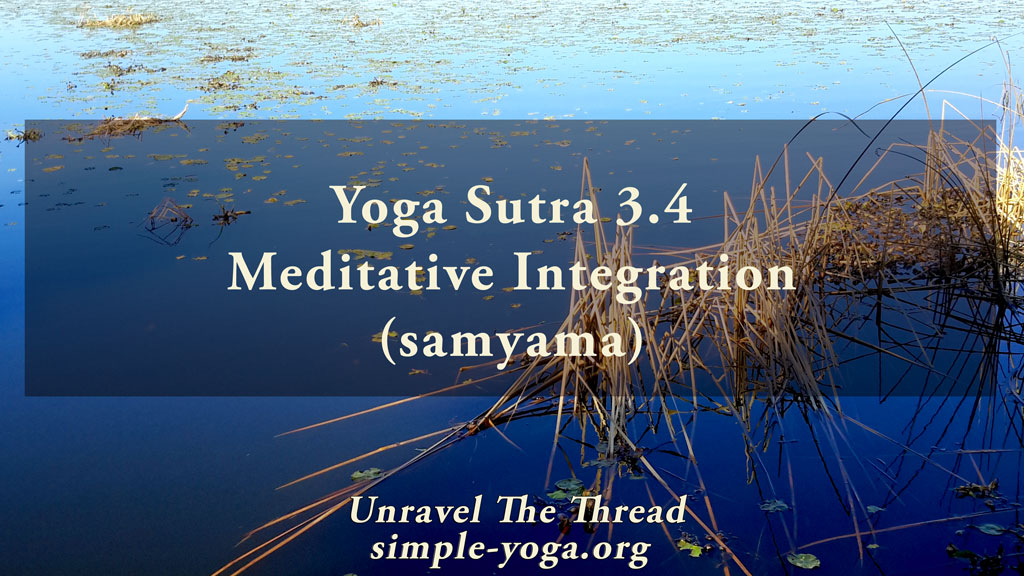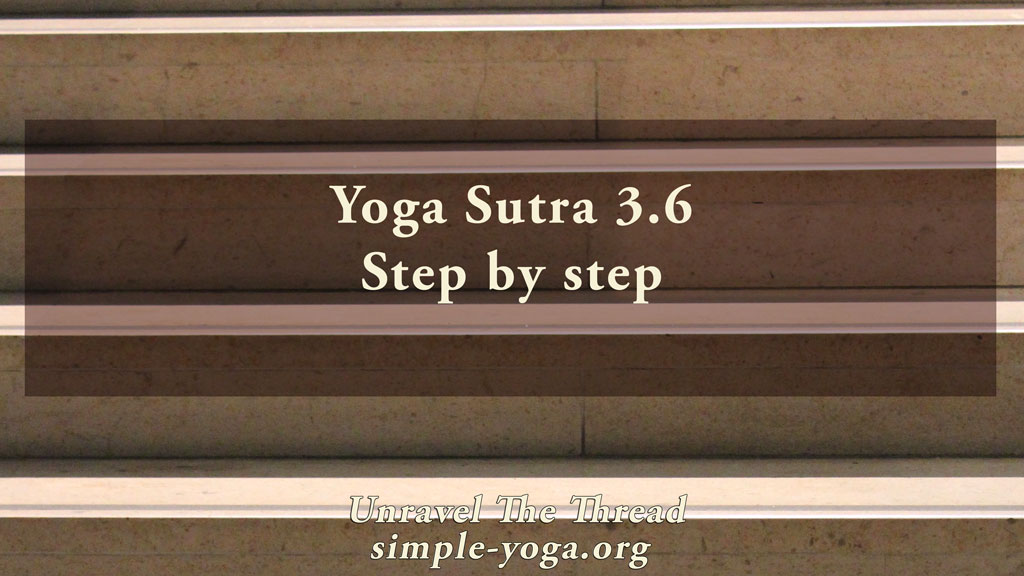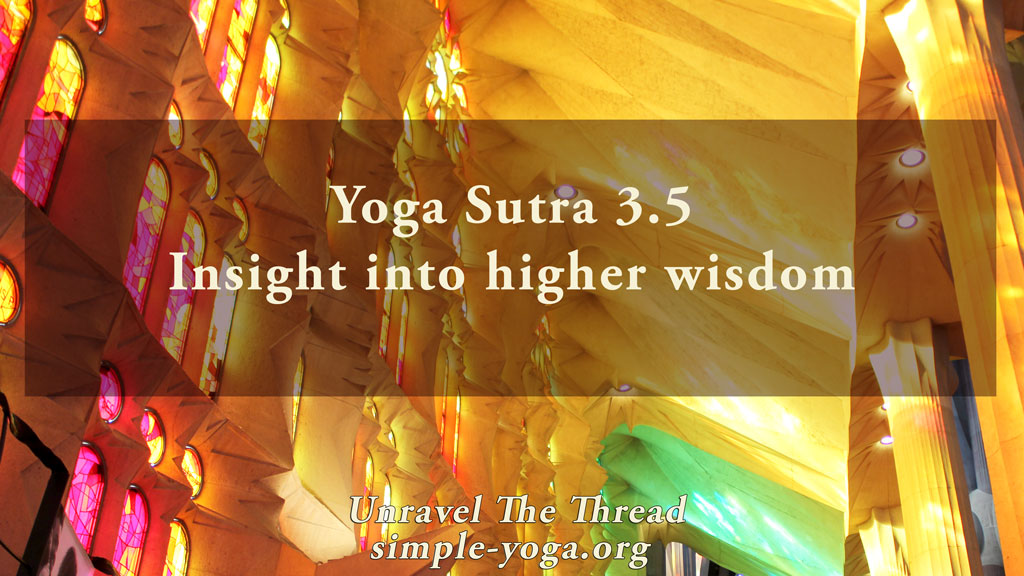
3.4 Meditative integration – samyama
June 12, 2021
3.6 Step by step
July 1, 2021
3.4 Meditative integration – samyama
June 12, 2021
3.6 Step by step
July 1, 20213.5 Insight into higher wisdom

3.5 Meditative integration (samyama) results in direct insight into higher wisdom.
This sutra echoes sutras 1.17, 1.18 and 1.49, where Patañjali enumerated the steps leading to integration (samadhi) and the culmination into connecting to wisdom that does not result from inference or somebody else’s testimony. The parallel between these sutras also reiterates that yoga is a dynamic process that develops at the natural pace that each practitioner can handle. This process begins by modulating your ways of being (1.3) to remove the obstacles that obstruct your natural awareness, love, and clarity. In other words, when awareness illuminates your understanding, extraordinary clarity results.
Meditative integration (samyama) is not a process of analysis or deduction. In fact, samyama is the release of all that you think you know so that you can gain undiluted insight into the constant interpenetration of life and consciousness. Rather than competing against your rational mind, insight complements it. It is important to recognize that in yoga you are not in conflict with your mind. Your mind is very useful and essential to your life. Fighting your mind wastes your valuable life energy. In fact, concentration starts by inviting the mind to focus, and it continues by softening the focus. Your mind helps you notice distractions and it also helps you return to your focal point. A useful strategy is to leverage your mind’s curiosity to lead you into exploring the subtler level of phenomena. As the previous sutra stated, it is a gradual process because it is quite difficult to perceive what is subtler if you cannot clearly perceive what is more apparent. You may use your curiosity to remain focused on something so that it reveals its subtler aspects. In addition to sharpening your concentration, there is another practical benefit to developing higher sensitivity: you become better able to notice insight.
Practicing the limbs of yoga presented in sutra 2.29 fosters the development of inner silence and stillness by decreasing reactivity and by removing obstructions at the mental, emotional, physical, and physiological level. The combination of inner silence and higher sensitivity facilitates perceiving insight. In fact, you are constantly receiving an unending stream of stimuli, both external and internal. For instance, when you are walking on the street, you learn to attend to what is most important while ignoring what seems unnecessary. That is a reason you do not remember all the people that were walking in the opposite direction or the cars that were on the road. Similarly, in your mind you are constantly ignoring many thoughts and other stimuli while favoring others. Insights are among the many stimuli that you perceive. Insights tend to be subtle and may be triggered by something somebody said, a sign on the street, a license plate, the shape of a cloud, a sound, the song playing on the radio, a scent, or some other sensation. Your yoga practice helps you recognize insight by distinguishing it from thoughts, opinions and stories. The mind is a vehicle for insight. Awareness yokes mind and insight together. When you perceive insight, you experience a knowing that resonates with you, even when the knowing is quite different from your usual ways of thinking. Although insight may appear unusual, it never contradicts common sense. Remember that wisdom is pure common sense. You can use your mind to verify this insight, because it is pure common sense that sparks a connection with a deeper source of truth. However, sometimes insight offers a subtle suggestion to move in a direction different from your preference or agenda. In those cases, it is key to clarify the distinction between intuition and your own preferences. Gaining access into greater insight opens a door into re-cognizing the world and all of existence through a transparent lens (samapatti 1.41). As a result, you may be able to relate to the world from a perspective of connectedness. Obviously, if there are still traces of reactivity and tendencies towards seeing yourself as separate, the insights gained could be used to advance those traits leading you to think and act motivated by personal gain and with complete disregard for others. So even at this level of practice, a firm foundation on the yamas and niyamas is essential.
As you become more practiced in connecting to your inner spaciousness, stillness, and silence, what do you discover?
How is your yoga practice fostering your receptivity?
Some people say that a flash of insight comes to them as images. Other people say that they just get a subtle hint or gentle knowing.
How does insight manifest in you?
Is it possible that your daily interactions and activities expose you to insight and wisdom on a regular basis?
As usual, one more way of exploring the meaning of this sutra is by chanting it.
You can choose to chant it in its traditional form with some of the words coming together:
3.5 tajjayāt prajñālokaḥ
तज्जयात् प्रज्ञालोकः ॥५॥
Another option is to chant each word in the sutra individually:
- tat
- jayāt
- prajñā
- lokaḥ
If you prefer, you may listen to the podcast:
Unravel the thread is now available as a book!
If you find Simple-Yoga.org and Unravel the thread useful, consider supporting my labor with a donation, you may also donate using PayPal or Venmo. Thank you!
